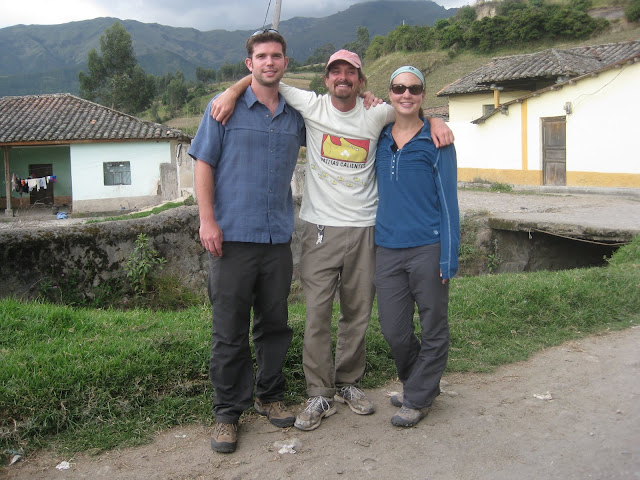 Ok, he´s not officially an Ecuadorian citizen yet, but that´s where his heart is. Meet Peter Shear, non-profit founder, father to two beautiful Ecuadorian girls, University of Michigan alumnus, and one of the most generous, genuine, and kind people I have ever met. Originally from Vermont, Peter has spent the better part of the past 14 years living in northern Ecuador, raising his family, and helping rural communities through his non-profit, the Inter-American Center for the Arts, Sustainability, and Action (CASA).
Ok, he´s not officially an Ecuadorian citizen yet, but that´s where his heart is. Meet Peter Shear, non-profit founder, father to two beautiful Ecuadorian girls, University of Michigan alumnus, and one of the most generous, genuine, and kind people I have ever met. Originally from Vermont, Peter has spent the better part of the past 14 years living in northern Ecuador, raising his family, and helping rural communities through his non-profit, the Inter-American Center for the Arts, Sustainability, and Action (CASA).
I first met Peter in Colorado in spring, 2008. Among his many different hats, Peter is the in-country director for a volunteer tour operator in Boulder, which brings him through town once a year. After hearing about the community development and tourism projects he´s been orchestrating in rural Ecuador, I knew a visit would be part of our RTW itinerary. It turned out to be way more than just a stop along the way.
Our first two weeks in Ecuador were spent under Peter´s wing, getting the behind-the-scenes stories about the successes and challenges of organizing a wide variety of community-driven economic projects. I was quite literally blown away by all he has accomplished. Have a look:
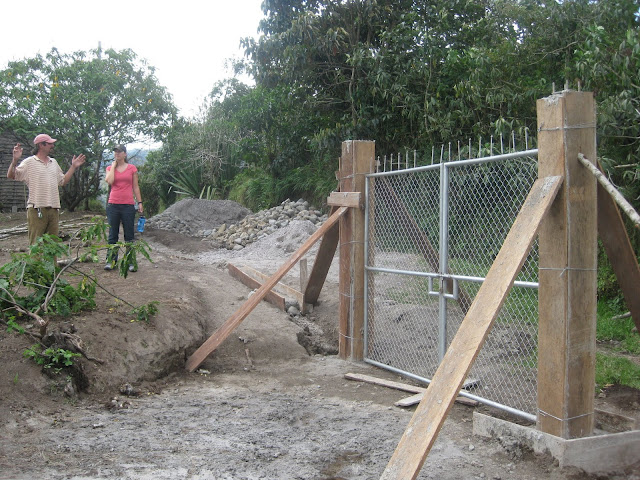 The Inter-American Center for the Arts, Sustainability, and Action is committed to helping rural communities realize sustainable economic development opportunities (or in non-jargon, helping poor people earn decent livings in ways that are good for their communities and regions). While CASA’s projects span a wide range of economic development initiatives, a core component is community-based and volunteer tourism. For over 7 years, CASA has been bringing groups of student and young-adult volunteers to the area, working side by side with the locals to build community projects and infrastructure that benefit the residents and the environment. Volunteers participate in “mingas”, organized project days where residents come together to work on a particular construction, farming, conservation, or other community-benefiting initiative. Funding for minga projects comes from local sources, as well as money raised by volunteers prior to their trips. To date, CASA volunteer tourism projects in a single community, Pucara, have included:
The Inter-American Center for the Arts, Sustainability, and Action is committed to helping rural communities realize sustainable economic development opportunities (or in non-jargon, helping poor people earn decent livings in ways that are good for their communities and regions). While CASA’s projects span a wide range of economic development initiatives, a core component is community-based and volunteer tourism. For over 7 years, CASA has been bringing groups of student and young-adult volunteers to the area, working side by side with the locals to build community projects and infrastructure that benefit the residents and the environment. Volunteers participate in “mingas”, organized project days where residents come together to work on a particular construction, farming, conservation, or other community-benefiting initiative. Funding for minga projects comes from local sources, as well as money raised by volunteers prior to their trips. To date, CASA volunteer tourism projects in a single community, Pucara, have included:
-
Building homes for residents in need (recipients of the homes were chosen by a community housing board that accepted applications and prioritized based on economic and social factors).
-
Construction of a community center for meetings, events, celebrations, weddings, etc. The center is the largest of its kind in all of the region, and has turned into a source of revenue for Pucara, as neighboring communities have begun renting it out. Proceeds from this program now pay for transportation for Pucara students to attend high school in the neighboring community of Apuela (prior to this program, most kids in Pucara did not attend high school due to the prohibitive transportation costs).
-
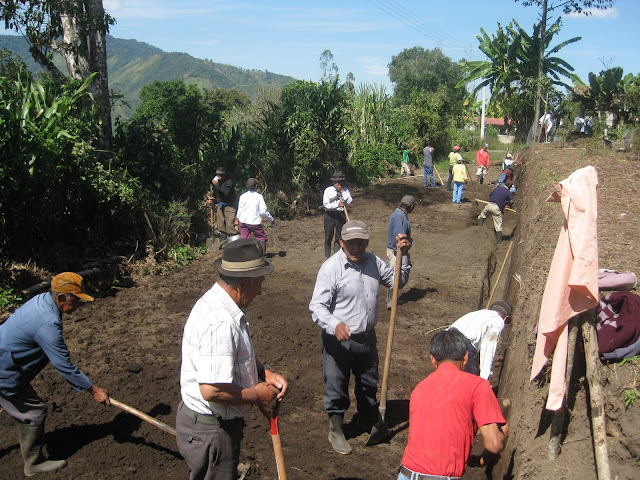 Purchase of land and construction of community organic gardens.
Purchase of land and construction of community organic gardens.
-
Purchase of land and construction of community farms. Some of the poorest residents in town have no land, and were in need of space for subsistence farming.
-
Construction of solar hot water showers for community use.
-
Construction of soccer field facilities.
-
Conservation through land purchasing, reforestation, and preservation.
-
Education through organic and agro-ecological farming instruction and testing.
This impressive list of projects, while organized and guided by Peter and CASA, was driven primarily by community initiation, participation, and democratic decision making. The result is a community with a much richer set of resources and infrastructure for creating new economic opportunities for local residents.
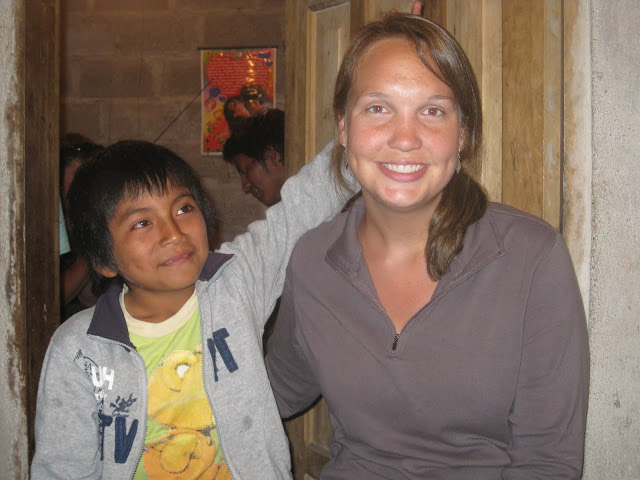 One of the most lucrative opportunities that has arisen from CASA’s work in Pucara is a well organized community-based tourism infrastructure, which we had the pleasure of participating in. While initially developed primarily for the volunteers, Pucara is now well equipped and actively receiving independent travelers interested in an authentic experience interacting with rural Ecuadorian families and communities. A rotating homestay program with 20 participating local families allows travelers the chance to live, eat, sleep, and participate in lives of the residents of Pucara for US$10 dollars per night (which includes 3 meals). The rotating nature of the program ensures an equal distribution to families throughout the community. The CASA-established Spanish school, the first of its kind in the region, allows travelers to hone their language skills while supporting local women teachers, all of which are government-certified. Of course, there are always volunteer opportunities available, independently or through community mingas.
One of the most lucrative opportunities that has arisen from CASA’s work in Pucara is a well organized community-based tourism infrastructure, which we had the pleasure of participating in. While initially developed primarily for the volunteers, Pucara is now well equipped and actively receiving independent travelers interested in an authentic experience interacting with rural Ecuadorian families and communities. A rotating homestay program with 20 participating local families allows travelers the chance to live, eat, sleep, and participate in lives of the residents of Pucara for US$10 dollars per night (which includes 3 meals). The rotating nature of the program ensures an equal distribution to families throughout the community. The CASA-established Spanish school, the first of its kind in the region, allows travelers to hone their language skills while supporting local women teachers, all of which are government-certified. Of course, there are always volunteer opportunities available, independently or through community mingas.
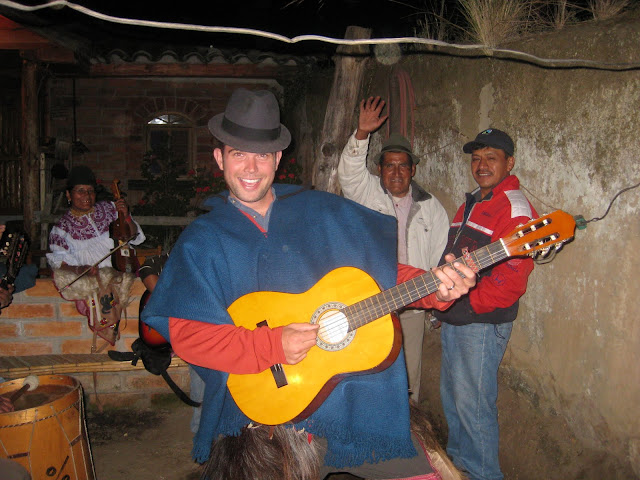 Impressive, right? What’s more impressive is that Pucara is only one of 5 communities across the northern Andes that Peter is working with, and each has its own set of projects, resources, accomplishments, challenges, and approach to community tourism (we were able to visit 4 of these communities with Peter).
Impressive, right? What’s more impressive is that Pucara is only one of 5 communities across the northern Andes that Peter is working with, and each has its own set of projects, resources, accomplishments, challenges, and approach to community tourism (we were able to visit 4 of these communities with Peter).
Peter is very humble about the achievements of CASA, and while he´s pleased with the progress of the communities, in his mind they´ve just begun. The list of potential projects grows weekly, and there are always bumps in the road to smooth out. But Peter is excited about what the future holds. The grand vision is to connect his work in each community through a multi-day community-to-community trek (think of Peru’s Inca Trail leading to Machu Picchu, only instead of camping near ruins, trekkers will stay with families in CASA communities along the route). Starting atop a glaciated volcano near the community of La Chimba, the 12 day trek will lead visitors through native forests, along active volcanoes and around alpine lakes, through the famous market town of Otavalo, and then descend into the cloud forest before culminating at a set of hot springs near Pucara. The Inti Chakinan Trail (or Sun Trail, in the local Kichwa language), as they’ve named it, will be hosting its first through-hiking guests this January. Want to go? I do.
It’s now been well over a month since our time with Peter in northern Ecuador, and one of the most significant lasting impressions is the motivation behind his dedication – the well-being of the people of the CASA communities. Peter’s work is selfless, genuine, and fully engaged with the people in these pueblos. Peter is no longer an outsider, a gringo, to the people of Pucara, Morochos, Peribuela, Pijal and La Chimba. He is an accepted, trusted, and appreciated member of their community. And when you’re visiting rural communities in a foreign culture, there’s nothing like a local to show you around.

 In my latest post for World Nomads, I talk about how Jaisalmer’s famous fort is being loved to death by locals and travelers alike. Check it out
In my latest post for World Nomads, I talk about how Jaisalmer’s famous fort is being loved to death by locals and travelers alike. Check it out  Botswana is home to some of the best safari camps (and wildlife viewing) on the planet. Famed for the Okavango Delta and the elephant-filled Chobe National Park, Botswana is a top destination on any safari-buff’s bucket list. And no company knows more about running successful camps in Botswana than
Botswana is home to some of the best safari camps (and wildlife viewing) on the planet. Famed for the Okavango Delta and the elephant-filled Chobe National Park, Botswana is a top destination on any safari-buff’s bucket list. And no company knows more about running successful camps in Botswana than 

 Pucara, Intag River Valley, Ecuador – The Intag River Valley, a gorgeous and lush mountain landscape northwest of Quito, is home to one of the most bio-diverse zones in all of Ecuador (a UNESCO biodiversity “hot-spot” and deemed one of the 10 most bio-diverse ecosystems in the world, due largely to its extreme elevation change – sea level to 11,000 ft in only a couple dozen miles). In addition to its one-of-a-kind forests, flora, and fauna, the region is also home to a wealth of valuable minerals and ores beneath its surface. A number of mining enterprises are in pursuit of digging rights, and many locals are tempted by the short-term financial returns promised by these companies. Without a financially viable alternative, the region is doomed to be exploited and destroyed by the mining industry.
Pucara, Intag River Valley, Ecuador – The Intag River Valley, a gorgeous and lush mountain landscape northwest of Quito, is home to one of the most bio-diverse zones in all of Ecuador (a UNESCO biodiversity “hot-spot” and deemed one of the 10 most bio-diverse ecosystems in the world, due largely to its extreme elevation change – sea level to 11,000 ft in only a couple dozen miles). In addition to its one-of-a-kind forests, flora, and fauna, the region is also home to a wealth of valuable minerals and ores beneath its surface. A number of mining enterprises are in pursuit of digging rights, and many locals are tempted by the short-term financial returns promised by these companies. Without a financially viable alternative, the region is doomed to be exploited and destroyed by the mining industry. One of the most lucrative opportunities that has arisen from CASA’s work in Pucara is a well organized community-based tourism infrastructure. While initially developed primarily for the volunteers, Pucara is now well equipped and actively receiving independent travelers interested in an authentic experience interacting with rural Ecuadorian families and communities. A rotating homestay program with 20 participating local families allows travelers the chance to live, eat, sleep, and participate in lives of the residents of Pucara for US $10 dollars per night (which includes 3 meals). The rotating nature of the program ensures an equal distribution to families throughout the community. The CASA-established Spanish school, the first of its kind in Intag, allows travelers to hone their language skills while supporting local women teachers, all of which are government-certified. Travelers pay US $6 per hour for private lessons. Of course, there are always volunteer opportunities available, independently or through community mingas. The Intag River Valley also has a wealth of activities to offer visitors, from guided or independent hikes through protected areas and native cloud forest, to natural hot springs, local markets, and agro-ecological tours.
One of the most lucrative opportunities that has arisen from CASA’s work in Pucara is a well organized community-based tourism infrastructure. While initially developed primarily for the volunteers, Pucara is now well equipped and actively receiving independent travelers interested in an authentic experience interacting with rural Ecuadorian families and communities. A rotating homestay program with 20 participating local families allows travelers the chance to live, eat, sleep, and participate in lives of the residents of Pucara for US $10 dollars per night (which includes 3 meals). The rotating nature of the program ensures an equal distribution to families throughout the community. The CASA-established Spanish school, the first of its kind in Intag, allows travelers to hone their language skills while supporting local women teachers, all of which are government-certified. Travelers pay US $6 per hour for private lessons. Of course, there are always volunteer opportunities available, independently or through community mingas. The Intag River Valley also has a wealth of activities to offer visitors, from guided or independent hikes through protected areas and native cloud forest, to natural hot springs, local markets, and agro-ecological tours.